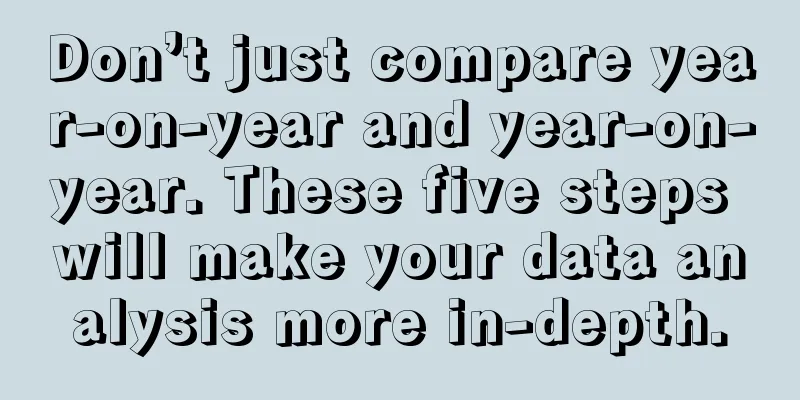Don’t just compare year-on-year and year-on-year. These five steps will make your data analysis more in-depth.

Many students always feel that the data analysis is not in-depth, and the PPT only contains year-on-year and year-on-year data. How should they do it? Today, I will share with you how to do an in-depth data analysis project based on a specific example. 1. Depth level: Level 0One day, you receive a request: "Look at the number of people who have used the newly added function A in our company's APP more than 1 time in the past 5 days (de-duplication)". This problem is too simple, just run a number and throw it in, "The cumulative number of users in the past 5 days is 10,000 people", and you're done. However, this kind of analysis is not in-depth at all, and it cannot even be called "analysis" at all. It is just a number. Indeed, when the demand is very specific data collection indicators + statistical time, this is just a number collection, and this is the 0th level of in-depth analysis. 2. In-depth level: Level 1One day, you receive another request: "Check out the newly added function A in our company's APP and see how many people are using it in the past 5 days." It sounds similar to the previous question, but please note that "how many people" is not a clear indicator, but a general statement. In detail, there are:
… It takes several indicators to combine to clearly explain how many people there are. Some students may think that this is too troublesome. I just assume that he can't see the duplicate number of people. In fact, a lot of repeated data collection at work, overtime work, and being chased by the business for data are all caused by "not confirming the requirements clearly and assuming an indicator that the business doesn't want." Especially when you ask the business: Which caliber do you want to see. The business will say: All. At this time, it is best to think of more in advance to avoid repeated rework. This kind of proactive thinking is the starting point for in-depth analysis, because these indicators are useful for business:
Moreover, we found that the results of level 0 become part of the output of level 1. The same is true for the follow-up. The deeper you go, the more indicators and dimensions you design, and the more complicated the problem will be. 3. Depth level: Level 2One day, you receive another request: "Take a look at the new function A added to our APP. Are the payment behaviors of people who have used it in the past 5 days better than others?" Note that there are no clear data indicators here, so we need to break down the problem first:
With these three steps of decomposition, this unclear requirement can be turned into a data retrieval requirement:
In this way, once the two groups are compared, a conclusion can be drawn. However, doing so will quickly lead to the next question: "Why are people who use A higher/lower than other groups?" IV. Depth level: Level 3One day, you receive another request: "Analyze why people who use function A pay better?" Note that asking if it is true first and then why is the basic requirement for answering questions. Therefore, when breaking down the problem, you must first complete the in-depth 2nd level homework. After confirming that "paying for function A is better", analyze the reasons. When analyzing the reasons, assumptions are important. Since the demand focuses on function A, the key is whether function A is useful. When analyzing the reasons, it is easier to disprove than to prove, so we can first eliminate some obviously wrong answers, such as "users of function A are all high-paying groups", which can directly eliminate "function A is useful for paid conversions". But this is not logically tenable, because:
… Even if we see the data: Group A's consumption is naturally higher than that of non-groups, there are still at least four possibilities that need to be ruled out. So we need to list the hypothesis logic tree clearly and check the possibilities one by one. This is also what we said: to verify the viewpoint, we need to find examples of both positive and negative sides at the same time. Note that even so, there are still counterarguments. Because we are all based on past data analysis, it is very likely that a counterargument is: "Function A can only attract this small group of users and cannot be expanded" or "User A is just trying something new, and it will have no effect after this period of time." Both of these viewpoints involve future data conditions, so it takes a period of observation before a conclusion can be drawn. If we can’t wait that long, we can also do tests. For example, to test the point of “not being able to expand”, we can actively promote function A to other groups and observe the incremental and retention effects of function A. If the incremental effect is small, or there is incremental effect but the retention effect is poor, then we can infer that it is indeed not able to expand. If we want to do in-depth analysis, testing and long-term observation are indispensable. Good conclusions need time to settle. 5. Depth level: Level 4One day, you receive another request: "Analyze the impact of function A on users?" It seems that the question is simpler to express, but it is more complicated to solve. Because from level 0 to level 3, we only discussed the impact of "payment", but there may be more impacts, such as activity, retention, referrals, etc. Each direction must go through such a long split and analysis to get a comprehensive result. So far, our analysis has been very in-depth. Interestingly, our problem is actually very simple. In fact, if a problem:
Then this problem can be easily solved. But the real problem is often:
At this time, you can start from the beginning and sort it out bit by bit. Reversing the order of this article is to sort out the scenarios of business problems from 0. Of course, not all analyses need to be done from beginning to end.
The only thing you should not do at this time is not to communicate, just come up with some numbers randomly, or find so-called "models" on the Internet and apply them mechanically. If you work behind closed doors, rework, overtime, and being dissed are common. If we have done many verifications in a certain business scenario and proved the key indicators + judgment criteria + causal relationship of the business problem, we can directly apply it at this time. This is what we call: business analysis model. However, before it is precipitated, we still need to do more demonstration, especially the causal relationship demonstration. If it is not done in detail, we will be slapped in the face in minutes. Author: Down-to-earth Teacher Chen Source: WeChat public account "Down-to-earth Teacher Chen" |
<<: Who says hot topics are hard to grasp? Three ways to create hot topics and attract attention
Recommend
Will an Amazon account be cancelled if it is not used for a long time? How long does it take to cancel it?
Now, no matter which software you use, if you want...
Non-standard product business in private domain
In this article, the author believes that "pr...
Pinduoduo Temu European semi-hosted merchants product delivery & inventory & shipping template operation
After Pinduoduo's Temu semi-hosting model beca...
How to apply for Shopee parent-child account? What are the requirements?
In the process of operating a Shopee store, it is ...
How to handle VAT in Europe when running an independent website? How to pay VAT?
There are still many merchants doing independent c...
10 very interesting copywriting
The author shared 10 very interesting copywritings...
Does Amazon China have traffic? What is the traffic within the site?
With the continuous development of the Amazon plat...
What is the difference between Amazon's order volume and sales volume? Is sales volume the monthly sales volume?
If you are a novice doing business on Amazon, you ...
How to achieve a breakthrough in marketing during the World Cup?
For brands, the World Cup not only generates emoti...
The lines from the movie "Catching Dolls" are terrifying when you think about it~
Recently, the new movie "Catching Dolls"...
How is it to open a store on eBay now? What are the prospects?
When it comes to eBay, many people's impressio...
The critical attack on the plush toys was caused by JellyCat's "madness"
JellyCat plush toys are popular all over the world...
What benefits are available to new sellers on Amazon Japan? How can I claim them?
In order to help sellers open stores in Japan and ...
If we continue to do this, there will be fewer and fewer people starting businesses!
This article deeply analyzes the challenges and di...
Does Shopee provide traffic support for new stores? How can new stores increase traffic?
When opening a new store, the speed of placing an ...









